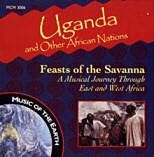 |
EOL CD review Uganda and Other African Nations Produced by Yuji Ichihashi, Aki Sato, and Stephen
McArthur. Recorded by Jun Mori. Multicultural
Media: Music of the Earth MCM3006. 1997. Compact disc. Liner notes by Jun Mori; photos
and map. |
| Feasts of the Savannah is a
compilation of field recordings by Japanese professor of ceramic arts Jun Mori. Spanning a
period from 1970-1986, the eighteen tracks represent a sonic travelogue of Mori’s
travels in sub-Saharan Africa, thus the title A Journey
Through East and West Africa. East Africa is represented by Uganda; West Africa is
represented by Cameroon, Togo, Senegal, Mali, and Ghana. According to the producers, these
aural snapshots of Mori's experiences are sequenced to "achieve musical flow."
Tracks 1-5 are from West Africa, tracks 6-13 are from Uganda, followed by tracks 14-18
which feature Togo, Mali, and Senegal. The duration of the selections average around three
minutes, the shortest being 0:34 ("Traditional Doctor’s Cure") and the
longest, 6:10 ("Children’s Song"). The selections can more accurately be
termed excerpts, since the frequent fade-in at the beginning of a selection and fade-out
at the end reveal little information on song form. Each excerpt is accompanied by a date
of recording, place of recording, and scattered information as to instrumentation and song
titles. Song texts are not included. Problems of insufficient detailed song information and instrumentation, and over-generalized social context stem from the production process. The CD originally released in 1992 in Japan by Victor Company of Japan (JVC) and Smithsonian/Folkways Records (USA) is part of Multicultural Media’s aim to reissue field recordings by a variety of fieldworkers from diverse disciplines. But given Jun Mori's unclear association with the National Museum of Ethnology, this recording can more appropriately be considered a travelogue of sound rather than a purely scholarly enterprise. Further problems are found in the transliteration between indigenous African languages to Japanese and then into English. I have attempted to correct inconsistencies by referring to scholarly dictionaries of music. |
|
Viewed as a
travelogue, the CD presents interesting perceptions towards world music from a
non-musicologist. The liner notes are presented as field notes entitled "Africa and
Me," "Astonishment and Deep Impressions," and "Bubbling Rhythm."
Fascination with the inclusion of music in many aspects of life reflect both scholars' and
travelers' interest in how rhythms and percussion are prominent in West Africa. These
sections provide for the musicologist over-generalized descriptions of some musical events
and for the casual listener an introduction to the fieldworker’s enthusiasm for the
music. |
|
.au, 70 KB |
The fidelity is of high quality and with the inclusion of place and date of recording, these elements can be valuable for researchers, even though the CD lacks scholarly rigor. Still, tracks such as "Sock Selue," a work song performed every few years by women when preparing a communal work area can provide important documentation for comparison and future work. |
| Timothy Mangin is a doctoral student in ethnomusicology at Columbia University. He is currently researching Mbalax and Sabar music from Senegal where he conducted field research in 1997. His past work has focused on American popular music, specifically jazz, acid jazz, and hip hop. |
|